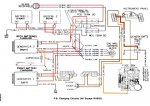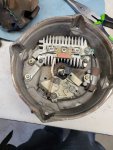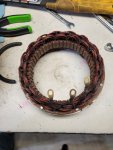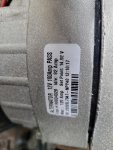LouhiKhar
New member
- 14
- 16
- 3
- Location
- New Hampshire
Hey all,
I don't think I'm retreading an existing issue, but correct me if I'm wrong...
Sorry for the novel... I have been trying to make sure I cover the "Duh" things first, and provide enough information here to be useful.
1986 M1008. The issue I'm trying to resolve right now is with the Gen 2 light. I know... But not *THAT* Gen 2 light issue... I've tried searching threads here, I've been poring over the TMs, and I haven't been able to find exactly what I'm dealing with.
The issue I started with was the Gen 2 light flashing when driving, especially with extra loads, like heat and headlights on. I followed the alternator testing threads and the TMs, and came to the conclusion I had a failing regulator. Through a series of unfortunate events, I ended up buying a Wilson 90-01-4277, basically a reman Delco 27SI with isolated ground, and installing that.
Now I have mostly the same problem... Still get some flashing of the Gen 2 light. I think it's slightly less than before, but same basic issue...
I didn't have a second set of hands originally, but after seeing the same basic issue, I got someone to help me out. What appears to be happening is that the voltage across the battery seems to decrease as RPMs increase, and I later confirmed this comparing fast idle to slow idle. At fast idle, I see ~14.8V over the second battery, and ~15V at slow idle. With someone revving the engine, I see the voltage drop to ~14.5V at times. I was thinking maybe the belt was slipping, but I don't hear any squealing and replacing the belt didn't affect the issue. I thought that the original alternator was supposed to have a 14.8V output, but I noticed the new alternator has a sticker stating a 14.92V setpoint. So maybe that's a factor too. As I understand it, the light turns when the battery voltage and setpoint are far enough apart, basically the output of a comparator. Maybe, if my memory is a correct (unlikely, but plausible) and the set point here is higher, I'm getting flashing when I wouldn't have with the original alternator... But that doesn't explain the charging voltage dropping when the engine is revved...
I have a battery tester, and both batteries pass cold cranking tests, so I don't think I have a bad battery. To double-check, I swapped the batteries, and didn't see much difference. Batteries appear to be ~2 years old, based on info on the stickers. They were installed before I bought the truck last year, so I'm not 100% sure. They appear to have been manufactured in January and February of 2022.
I checked to see if there was a larger than expected resistance between the alternator and the battery, but saw a dead short, so far as my multimeter could tell. I could try current-based test during start or something to get a better sense, as most multimeters can't reliable read below 0.3 ohms or so, but I haven't had a chance yet.
So I don't think I have bad batteries and the alternator is brand new... The wiring seems to match the wiring diagrams in the TMs...
My next thoughts were maybe the Gen 2 light relay is failing, or maybe the resistors are failing... I will note that I have noticed some odd gremlins in the electrical system. If I have high beams on for too long, my dash lights tend to go out. Turning high beams off and a little bit of time has my dash lights come back. It doesn't pop fuses, but lights simply turn off until the scenario is cleared, then they just come back...
So I'm in a weird spot... Based on the minimum 14.5V I measured, it should be (and seems to be, based on my measurements) enough to charge the second battery. So functionally, it seems to be OK. I'm simply concerned it will lead to other issues or is forewarning me of problems to come (like the resistors completely failing or something). The truck starts, drives, and seems to charge both batteries OK.
I still have plenty of things to do on the truck, and it originally felt like this one should have been an easy enough problem to solve. Gen 2 light comes on, measurements indicated alternator regulator, replace it. But that hasn't fixed the issue...
For completeness, I'll note that I did install a Fluidampr in October, but that's the only change to the engine I've made, aside from basic maintenance (oil change, new glow plugs, etc.). All lights in the dash have been replaced with LEDs, except the Gen 1 and Gen 2 lights, which have a traditional 168 and a 192 bulb in them. The truck did have a disabled waste vegetable oil system in it, which I have mostly removed, but there were some electrical changes, tying its computer into some sensors and the like. It's possible something is going on there, but it wasn't doing this when I originally bought the truck, so I'm not convinced that is part of the immediate problem.
Should I replace the Gen 2 light relay? Should I look into the resistors? I'm not entirely sure where to look next...
Any suggestions?
Thanks all for the read and any help you can offer.
I don't think I'm retreading an existing issue, but correct me if I'm wrong...
Sorry for the novel... I have been trying to make sure I cover the "Duh" things first, and provide enough information here to be useful.
1986 M1008. The issue I'm trying to resolve right now is with the Gen 2 light. I know... But not *THAT* Gen 2 light issue... I've tried searching threads here, I've been poring over the TMs, and I haven't been able to find exactly what I'm dealing with.
The issue I started with was the Gen 2 light flashing when driving, especially with extra loads, like heat and headlights on. I followed the alternator testing threads and the TMs, and came to the conclusion I had a failing regulator. Through a series of unfortunate events, I ended up buying a Wilson 90-01-4277, basically a reman Delco 27SI with isolated ground, and installing that.
Now I have mostly the same problem... Still get some flashing of the Gen 2 light. I think it's slightly less than before, but same basic issue...
I didn't have a second set of hands originally, but after seeing the same basic issue, I got someone to help me out. What appears to be happening is that the voltage across the battery seems to decrease as RPMs increase, and I later confirmed this comparing fast idle to slow idle. At fast idle, I see ~14.8V over the second battery, and ~15V at slow idle. With someone revving the engine, I see the voltage drop to ~14.5V at times. I was thinking maybe the belt was slipping, but I don't hear any squealing and replacing the belt didn't affect the issue. I thought that the original alternator was supposed to have a 14.8V output, but I noticed the new alternator has a sticker stating a 14.92V setpoint. So maybe that's a factor too. As I understand it, the light turns when the battery voltage and setpoint are far enough apart, basically the output of a comparator. Maybe, if my memory is a correct (unlikely, but plausible) and the set point here is higher, I'm getting flashing when I wouldn't have with the original alternator... But that doesn't explain the charging voltage dropping when the engine is revved...
I have a battery tester, and both batteries pass cold cranking tests, so I don't think I have a bad battery. To double-check, I swapped the batteries, and didn't see much difference. Batteries appear to be ~2 years old, based on info on the stickers. They were installed before I bought the truck last year, so I'm not 100% sure. They appear to have been manufactured in January and February of 2022.
I checked to see if there was a larger than expected resistance between the alternator and the battery, but saw a dead short, so far as my multimeter could tell. I could try current-based test during start or something to get a better sense, as most multimeters can't reliable read below 0.3 ohms or so, but I haven't had a chance yet.
So I don't think I have bad batteries and the alternator is brand new... The wiring seems to match the wiring diagrams in the TMs...
My next thoughts were maybe the Gen 2 light relay is failing, or maybe the resistors are failing... I will note that I have noticed some odd gremlins in the electrical system. If I have high beams on for too long, my dash lights tend to go out. Turning high beams off and a little bit of time has my dash lights come back. It doesn't pop fuses, but lights simply turn off until the scenario is cleared, then they just come back...
So I'm in a weird spot... Based on the minimum 14.5V I measured, it should be (and seems to be, based on my measurements) enough to charge the second battery. So functionally, it seems to be OK. I'm simply concerned it will lead to other issues or is forewarning me of problems to come (like the resistors completely failing or something). The truck starts, drives, and seems to charge both batteries OK.
I still have plenty of things to do on the truck, and it originally felt like this one should have been an easy enough problem to solve. Gen 2 light comes on, measurements indicated alternator regulator, replace it. But that hasn't fixed the issue...
For completeness, I'll note that I did install a Fluidampr in October, but that's the only change to the engine I've made, aside from basic maintenance (oil change, new glow plugs, etc.). All lights in the dash have been replaced with LEDs, except the Gen 1 and Gen 2 lights, which have a traditional 168 and a 192 bulb in them. The truck did have a disabled waste vegetable oil system in it, which I have mostly removed, but there were some electrical changes, tying its computer into some sensors and the like. It's possible something is going on there, but it wasn't doing this when I originally bought the truck, so I'm not convinced that is part of the immediate problem.
Should I replace the Gen 2 light relay? Should I look into the resistors? I'm not entirely sure where to look next...
Any suggestions?
Thanks all for the read and any help you can offer.
Last edited:






